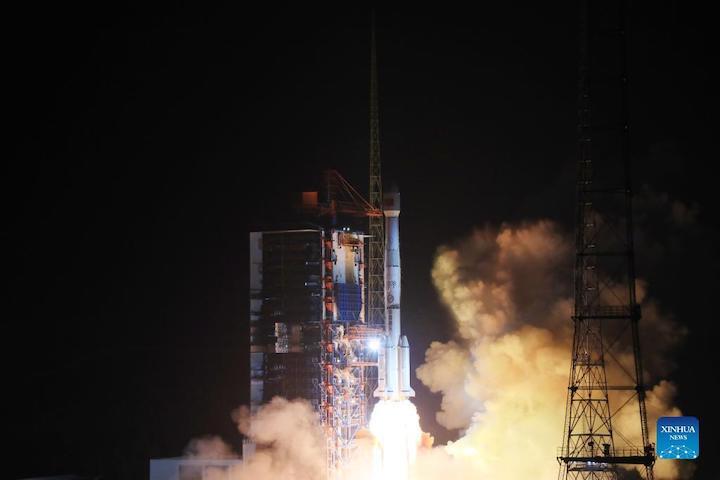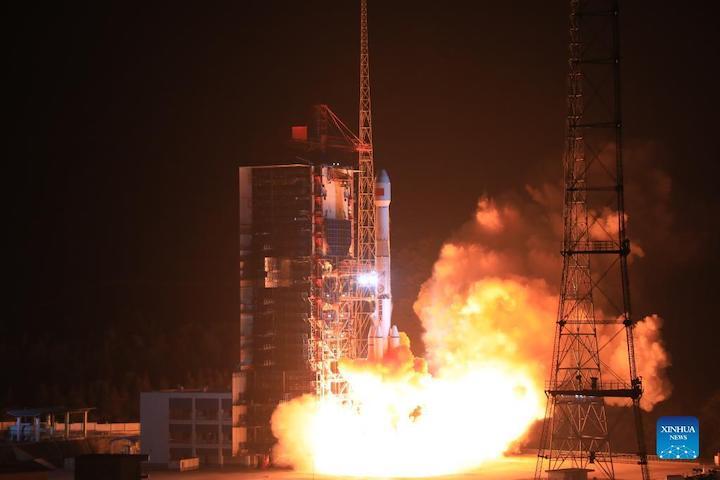14.12.2021

A Long March-3B carrier rocket carrying the Tianlian II-02 satellite blasts off from the Xichang Satellite Launch Center in southwest China's Sichuan Province, Dec. 14, 2021. China sent a new data relay satellite into orbit early Tuesday morning. (Photo by Zheng Zhongli/Xinhua)
China sent a new data relay satellite into orbit from the Xichang Satellite Launch Center in southwest China's Sichuan Province early Tuesday morning.
The Tianlian II-02 satellite was launched at 0:09 a.m. Beijing Time by a Long March-3B carrier rocket.
It was the 401st flight mission of the Long March carrier rocket series. Enditem

A Long March-3B carrier rocket carrying the Tianlian II-02 satellite blasts off from the Xichang Satellite Launch Center in southwest China's Sichuan Province, Dec. 14, 2021. China sent a new data relay satellite into orbit early Tuesday morning. (Photo by Zheng Zhongli/Xinhua)
Quelle: Xinhua
+++
China launches second Tianlian II communication satellite
China has launched the second satellite for the Tianlian II tracking and data relay series. This satellite enables communications between spacecraft and is part of the new series of Tianlian satellites, after the initial launch of the first Tianlian II in March of 2019.
The liftoff occurred at 00:09 local time on December 14 from the Xichang Satellite Launch Center. The launch vehicle was a Chang Zheng 3B/E and the launch was confirmed a success by the China National Space Administration (CNSA). The target orbit for the Tianlian satellites is a Geostationary Orbit (GEO).
The Tianlian satellites are used to provide a data relay for crewed vehicles and space assets of the Chinese program. This includes communication with the Chinese Space Station and low Earth orbit resource satellites.
The first Tianlian II satellite has been in use since December 2019. It was used to control Shenzhou missions and the Tiangong space station. The updated second generation of this has a lifespan of 15 years and weighs 600 kg. In contrast to the first generation of the satellites, which is using the S-band with 2 GHz, the second uses the k-band with more than 20 GHz. This leads to speeds up to 1.2 Gbit/s between the Chinese Space Station and mission control in Peking.
Before Tianlian II, China launched the first generation of Tianlian satellites. The first launch occurred in April of 2008, followed by four more launches. The last one took place this year on a Chang Zheng-3C/E.
The Chang Zheng 3B/E, also referred to as the 3B/G2, is a three stage orbital launch vehicle built by the China Academy of Launch Vehicle Technology (CALT). It is the boosted version of the previously flown Chang Zheng 3B rocket which features updates to the center stage and the liquid rocket boosters on the side of the vehicle.
It features a payload capacity of 11,500 kg to Low Earth Orbit (LEO) and 5,500 kg to a Geostationary Transfer Orbit (GTO). Most of its launches have GTO as a destination, including Tianlian II. It is the workhorse of the Chinese space program and the most flown rocket of all the rockets ever built by China. Its main use is the launch of communications and telecommunications satellites, as they often operate in GEO.
Previously, CZ-3B launched the ChinaSat 1D mission last month. In the past it has been used for historic launches, such as the first lunar lander of China and the first landing on the far side of the moon.
Up to date only four problematic missions occurred with the Chang Zheng 3B family, including the Intelsat 708 tragedy. The first launch in February 1996 failed just after liftoff and the rocket veered off course, hitting populated areas. The Xinhua news agency reported six people dying in the incident, however, these numbers might not be accurate and appear to be even higher in reality.
The last failure of the configuration was the Palapa-N1 launch failure in April 2020. After the first and second stage of the launch vehicle performed well, the third stage never made it past ignition which resulted in a complete loss of payload.
The rocket is 56 meters tall with a liftoff mass of 458,970 kg. While today it only appeared in its three stage configuration, it can feature up to four stages, with the potential of an added Yuanzheng-1 upper stage. The last use of this option is already two years old.
At the bottom of the rocket is the first stage, which is standing 24.76 meters tall with a diameter of 3.35 meters. It features four YF-21C engines that provide a thrust at liftoff of 2961.6 kN and a specific impulse of 260 seconds.
Next to it are the four liquid side boosters. Equipped with a smaller diameter of 2.25 meters and a height of 16.1 meters, they are ignited together with the center core at liftoff. They use the same YF-20C engine, which also is the base for the YF-21C center engine. In this configuration, it is called YF-25. All four of them together double the thrust of the center core and provide another 2961.6 kN, bringing the liftoff thrust of the 3B/E to 5923.2 kN.
The engine runs on a combination of dinitrogen tetroxide (N2O4) and dimethylhydrazine (UDMH). The hypergolic combination will burn as soon they making contact with each other. It is the origin of the red smoke the Chang Zheng 2/3/4 rockets produce at liftoff.
After more than two minutes, the four liquid rocket boosters are jettisoned away from the main stage, leaving the lifting duty to the center core. It will burn for 18 more seconds before main engine cutoff (MECO). At this point the second stage takes over and ignites its single YF-22E upper stage engine.
Stage two provides 742 kN of thrust and can use the four YF-23F engines to steer the rocket during the burn. The second stage is only half the size of the first stage at 12.92 meters, but shares the same diameter.
After the second stage did its lifting, the third stage was ignited for the final placement into GTO. It stands 12.38 meters tall and is, in contrast to the first stages, fueled by liquid hydrogen and liquid oxygen. It is powered by two YF-75 engines which produce 78.45 kN and a high specific impulse of 438 seconds.
The launch occurred from the Xichang Satellite Launch Center in southern China. Since 1984 it has hosted Chang Zheng 2 and Cheng Zheng 3 rockets. It will feature a new launch pad in the future for the launch of Chang Zheng 8 and other new Chinese rockets.
Quelle: NS
